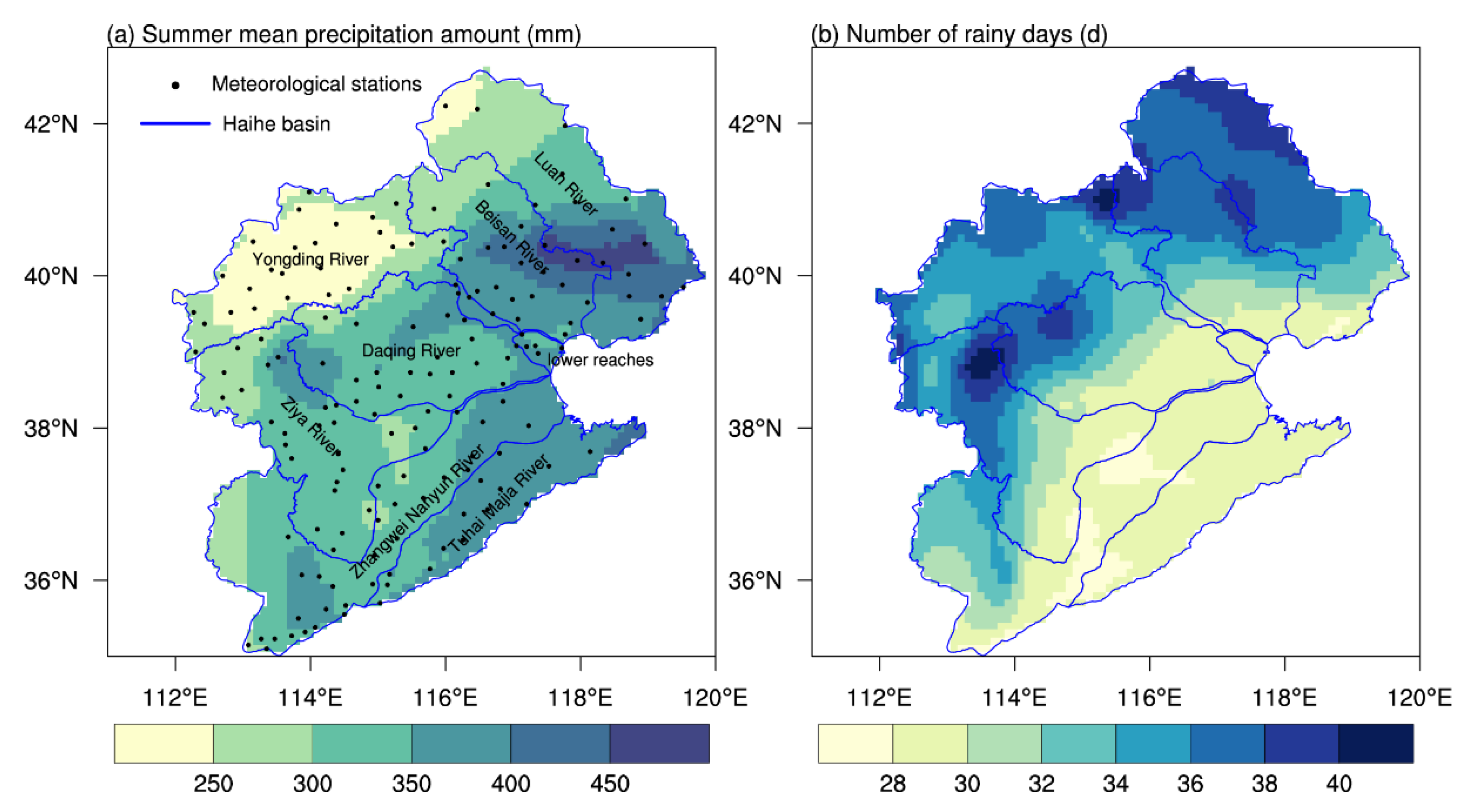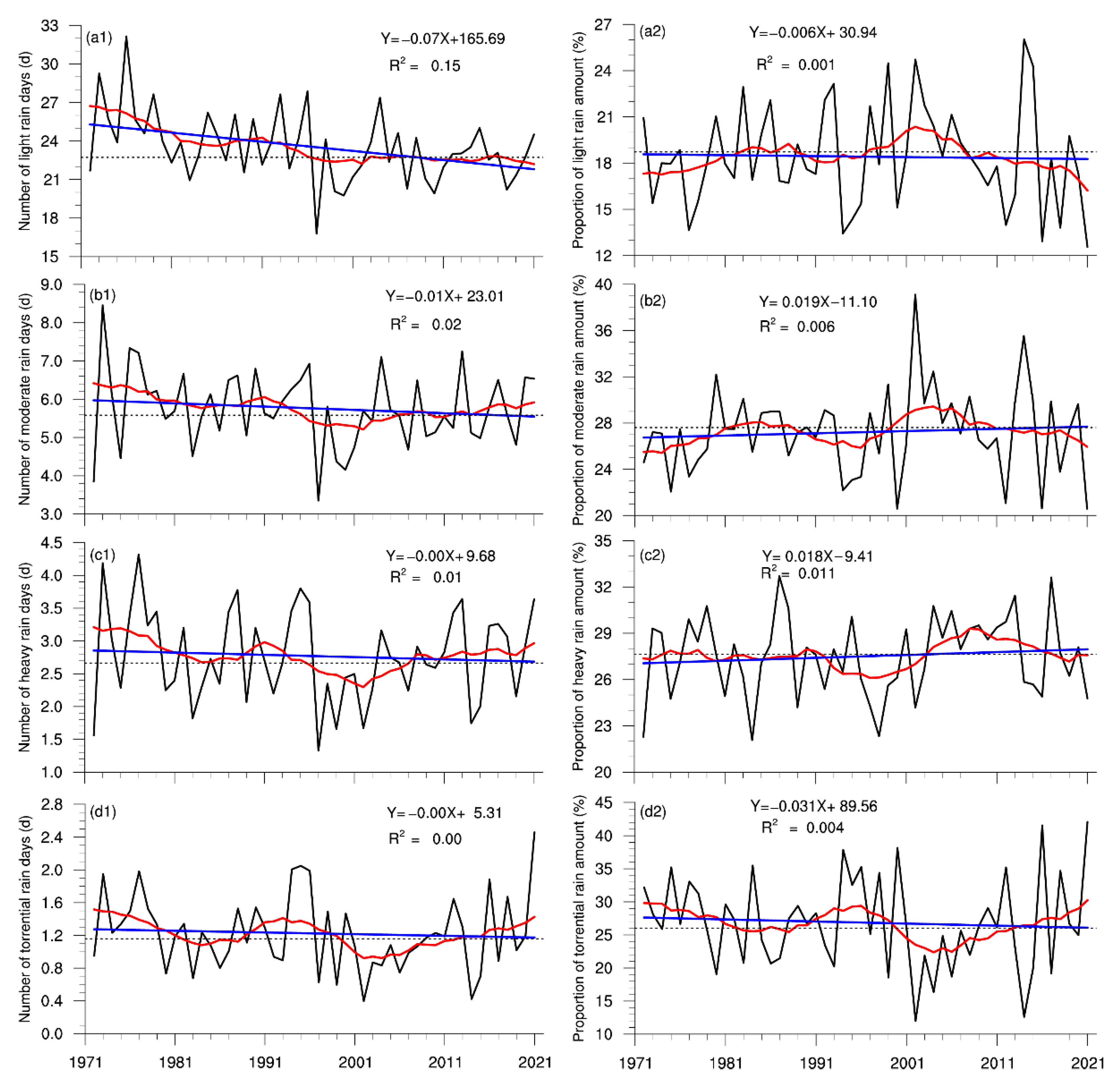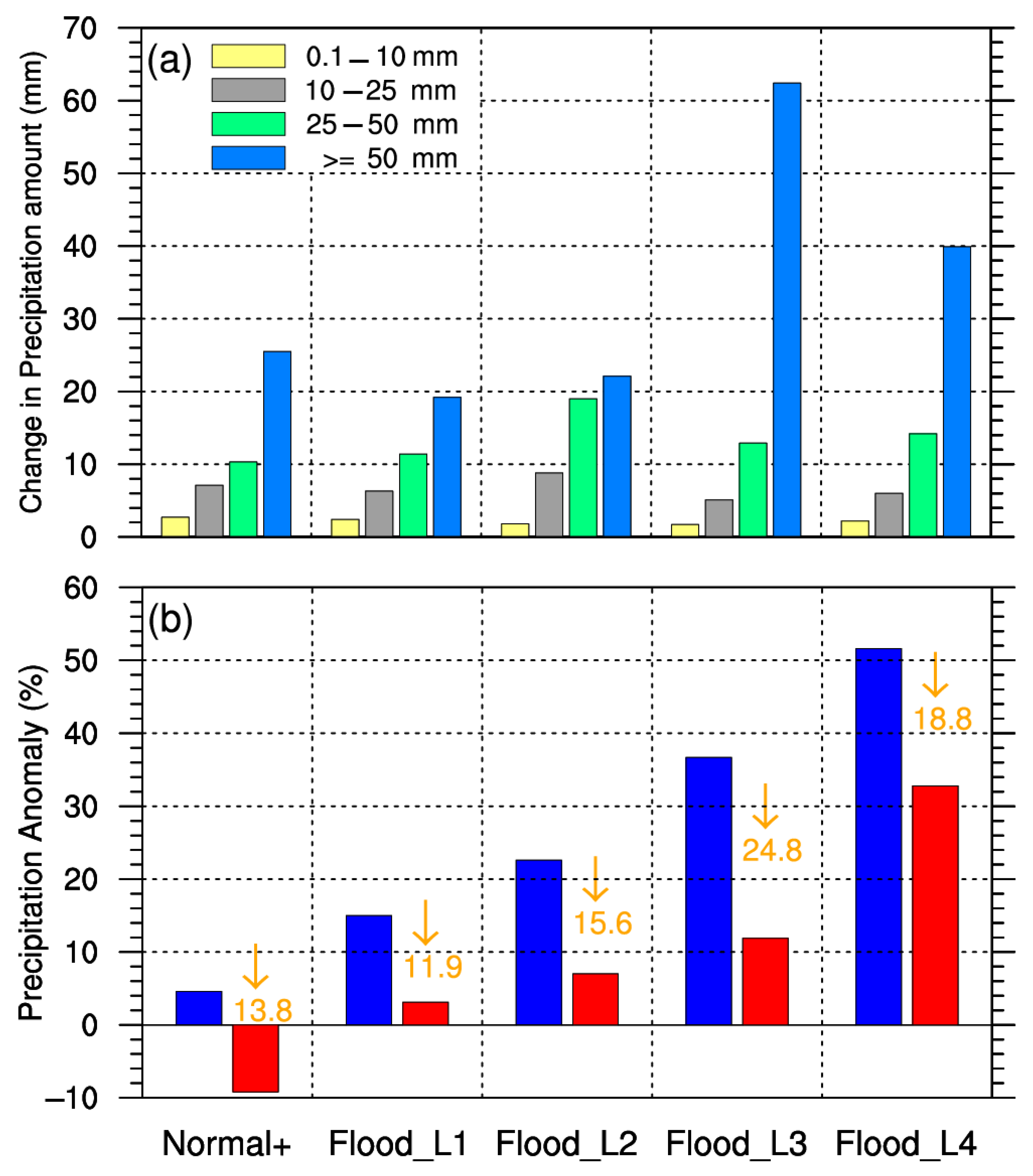Variations in Summer Precipitation According to Different Grades and Their Effects on Summer Drought/Flooding in Haihe River Basin
Abstract
:1. Introduction
2. Materials and Methods
2.1. Study Area
2.2. Data and Methods
3. Results
3.1. Variation in Summer Precipitation According to Different Grades
3.2. Effects of Different Precipitation Grades on Summer Drought/Flooding
4. Discussion
5. Conclusions
Supplementary Materials
Author Contributions
Funding
Institutional Review Board Statement
Informed Consent Statement
Data Availability Statement
Acknowledgments
Conflicts of Interest
References
- Cheng, S.; Guan, X.; Huang, J.; Ji, F.; Guo, R. Long-term trend and variability of soil moisture over East Asia. J. Geophys. Res. Atmos. 2015, 120, 8658–8670. [Google Scholar] [CrossRef] [Green Version]
- Cheng, S.; Huang, J. Enhanced soil moisture drying in transitional regions under a warming climate. J. Geophys. Res. Atmos. 2016, 121, 2542–2555. [Google Scholar] [CrossRef]
- Zheng, J.; Yu, Y.; Zhang, X.; Hao, Z. Variation of extreme drought and flood in North China revealed by document-based seasonal precipitation reconstruction for the past 300 years. Clim. Past 2018, 14, 1135–1145. [Google Scholar] [CrossRef] [Green Version]
- Zou, X.; Zhai, P.; Zhang, Q. Variations in droughts over China: 1951–2003. Geophys. Res. Lett. 2005, 32, L04707. [Google Scholar] [CrossRef]
- Li, W.; Pan, R.; Jiang, Z.; Chen, Y.; Li, L.; Luo, J.-J.; Zhai, P.; Shen, Y.; Yu, J. Future changes in the frequency of extreme droughts over China based on two large ensemble simulations. J. Clim. 2021, 34, 6023–6035. [Google Scholar] [CrossRef]
- Feng, W.; Zhong, M.; Lemoine, J.M.; Biancale, R.; Hsu, H.T.; Xia, J. Evaluation of groundwater depletion in North China using the Gravity Recovery and Climate Experiment (GRACE) data and ground-based measurements. Water Resour. Res. 2013, 49, 2110–2118. [Google Scholar] [CrossRef]
- Orsolini, Y.J.; Zhang, L.; Peters, D.H.; Fraedrich, K.; Zhu, X.; Schneidereit, A.; van den Hurk, B. Extreme precipitation events over north China in August 2010 and their link to eastward-propagating wave-trains across Eurasia: Observations and monthly forecasting. Q. J. R. Meteorol. Soc. 2015, 141, 3097–3105. [Google Scholar] [CrossRef]
- Jiang, X.; Yuan, H.; Xue, M.; Chen, X.; Tan, X. Analysis of a heavy rainfall event over Beijing during 21–22 July 2012 based on high resolution model analyses and forecasts. J. Meteorol. Res. 2014, 28, 199–212. [Google Scholar] [CrossRef] [Green Version]
- Zhang, D.L.; Lin, Y.; Zhao, P.; Yu, X.; Wang, S.; Kang, H.; Ding, Y. The Beijing extreme rainfall of 21 July 2012:“Right results” but for wrong reasons. Geophys. Res. Lett. 2013, 40, 1426–1431. [Google Scholar] [CrossRef]
- Saini, A.; Sahu, N.; Kumar, P.; Nayak, S.; Duan, W.; Avtar, R.; Behera, S. Advanced rainfall trend analysis of 117 years over West Coast Plain and Hill Agro-climatic region of India. Atmosphere 2020, 11, 1225. [Google Scholar] [CrossRef]
- Saini, A.; Sahu, N.; Duan, W.; Kumar, M.; Avtar, R.; Mishra, M.; Kumar, P.; Pandey, R.; Behera, S. Unraveling Intricacies of Monsoon Attributes in Homogenous Monsoon Regions of India. Front. Earth Sci. 2022, 10, 794634. [Google Scholar] [CrossRef]
- Huang, R.; Chen, J.; Zhou, L.; Zhang, Q. Studies on the Relationship between the Severe Climatic Disasters in China and the East Asia Climate System. Chin. J. Atmos. Sci. 2003, 27, 770–787, (Chinese with English Abstract). [Google Scholar]
- Zhou, M. The Analysis of Long-Range Weather Process of Summer Drought and Flood in the Hai River Basin. Acta Meteorol. Sinica 1981, 39, 321–331, (Chinese with English Abstract). [Google Scholar]
- Guo, Z.; Chen, X.; Jiang, Y.; Dong, L. Interdecadal variation characteristics of water vapor transfer over eastern China in summer. Trans. Atmos. Sci. 2014, 37, 568–574, (Chinese with English Abstract). [Google Scholar]
- Hao, L.; Ding, Y.; Min, J. Relationship between Summer Monsoon Changes in East Asia and Abnormal Summer Rainfall in North China. Plateau Meteorol. 2016, 35, 1280–1289, (Chinese with English Abstract). [Google Scholar]
- Jiang, Z.; Jiang, S.; Shi, Y.; Liu, Z.; Li, W.; Li, L. Impact of moisture source variation on decadal-scale changes of precipitation in North China from 1951 to 2010. J. Geophys. Res. Atmos. 2017, 122, 600–613. [Google Scholar] [CrossRef]
- Yang, R.; Xing, P.; Du, W.; Dang, B.; Xuan, C.; Xiong, F. Climatic characteristics of precipitation in North China from 1961 to 2017. Sci. Geogr. Sin. 2020, 40, 1573–1583, (Chinese with English Abstract). [Google Scholar]
- He, L.; Hao, X.; Li, H.; Han, T. How Do Extreme Summer Precipitation Events Over Eastern China Subregions Change? Geophys. Res. Lett. 2021, 48, E2020GL091849. [Google Scholar] [CrossRef]
- Han, Y.; Liu, B.; Xu, D.; Yuan, C.; Xu, Y.; Sha, J.; Li, S.; Chang, Y.; Sun, B.; Xu, Z. Temporal and Spatial Variation Characteristics of Precipitation in the Haihe River Basin under the Influence of Climate Change. Water 2021, 13, 1664. [Google Scholar] [CrossRef]
- Zhang, Q.; Xu, C.; Zhang, Z.; Chen, Y.; Liu, C. Spatial and temporal variability of precipitation over China, 1951–2005. Theor. Appl. Climatol. 2009, 95, 53–68. [Google Scholar] [CrossRef]
- Liu, G.; Ren, G.; Fang, Z.; Zhang, C.; Yang, X. Trends of precipitation extremes in the Haihe River Basin during 1961–2007. J. Arid Land Resour. Environ. 2010, 24, 85–90, (Chinese with English Abstract). [Google Scholar]
- Du, H.; Xia, J.; Zeng, S.; She, D.; Liu, J. Variations and statistical probability characteristic analysis of extreme precipitation events under climate change in Haihe River Basin, China. Hydrol. Process 2014, 28, 913–925. [Google Scholar] [CrossRef]
- Wang, Z.; Luo, Y.; Liu, C.; Xia, J.; Zhang, M. Spatial and temporal variations of precipitation in Haihe River Basin, China: Six decades of measurements. Hydrol. Process 2011, 25, 2916–2923. [Google Scholar] [CrossRef]
- Sang, Y.; Wang, Z.; Liu, C. Spatial and temporal variability of precipitation extrema in the Haihe River Basin, China. Hydrol. Process 2014, 28, 926–932. [Google Scholar] [CrossRef]
- Yin, S.; Gao, G.; Li, W.; Chen, D.; Hao, L. Long-term precipitation change by hourly data in Haihe River Basin during 1961–2004. Sci. China Earth Sci. 2011, 54, 1576–1585. [Google Scholar] [CrossRef]
- Zhou, S.; Song, Y.; Li, Y.; Wang, C.; Yang, Y.; Huang, Y. Spatial distribution of summer graded precipitation and its difference in drought and flood years over the east of northwest China. Arid Land Geogr. 2016, 39, 1162–1171, (Chinese with English Abstract). [Google Scholar]
- Hao, L.; He, L.; Cheng, S.; Liang, S. Climatic characteristics and monitoring analysis of rainy season in the Haihe River Basin. Pro. Geogr. 2021, 40, 1181–1194, (Chinese with English Abstract). [Google Scholar] [CrossRef]
- Li, Q.; Liu, X.; Zhang, H.; Peterson, T.C.; Easterling, D.R. Detecting and Adjusting Temporal Inhomogeneity in Chinese Mean Surface Air Temperature Data. Adv. Atmos. Sci. 2004, 21, 260–268. [Google Scholar] [CrossRef]
- Li, Q.; Dong, W. Detection and adjustment of undocumented discontinuities in Chinese temperature series using a composite approach. Adv. Atmos. Sci. 2009, 26, 143–153. [Google Scholar] [CrossRef]
- Xu, Y.; Gao, X.; Shen, Y.; Xu, C.; Shi, Y.; Giorgi, F. A daily temperature dataset over China and its application in validating a RCM simulation. Adv. Atmos. Sci. 2009, 26, 763–772. [Google Scholar] [CrossRef]
- Huang, R.; Liu, Y.; Du, Z.; Chen, J.; Huangfu, J. Differences and links between the East Asian and South Asian summer monsoon systems: Characteristics and variability. Adv. Atmos. Sci. 2017, 34, 1204–1218. [Google Scholar] [CrossRef]
- Zhi, R.; Chen, L.; Zhu, X. Analysis of Characteristics and Causes of Precipitation Anomalies over Northern China in Autumn 2017. Meteorol. Mon. 2018, 44, 572–581, (Chinese with English Abstract). [Google Scholar]
- GB/T 28592-2012; Grade of Precipitation. Standards Press of China: Beijing, China, 2012; (Chinese with English Abstract).
- IPCC. The Physical Science Basis. In Contribution of Working Group I to the Fifth Assessment Report of the Intergovernmental Panel on Climate Change; IPCC: Geneva, Switzerland, 2013. [Google Scholar]
- Kumaraswamy, P. A generalized probability density function for double-bounded random processes. J. Hydrol. 1980, 46, 79–88. [Google Scholar] [CrossRef]
- Zhao, Y.; Xu, X.; Li, J.; Zhang, R.; Kang, Y.; Huang, W.; Xia, Y.; Liu, D.; Sun, X. The Large-Scale Circulation Patterns Responsible for Extreme Precipitation over the North China Plain in Midsummer. J. Geophys. Res. Atmos. 2019, 124, 12794–12809. [Google Scholar] [CrossRef] [Green Version]
- Liu, J.; Han, J.; Xiang, L.; Fan, Y. Temporal-spatial characteristics of precipitation day in different levels in Beijing-Tianjin-Hebei from 1961 to 2012. J. Meteorol. Environ. 2015, 31, 43–50, (Chinese with English Abstract). [Google Scholar]
- Ai, H.; Zhang, Y.; Lu, W. Characteristics of the interannual variations of summer precipitation days with different class intervals over Eastern China. Sci. Meteorol. Sin. 2009, 29, 299–306, (Chinese with English Abstract). [Google Scholar]
- Wang, X.; Zhai, P. Changes in China’s Precipitation in Various Categories during 1957–2004. J. Trop. Meteorol. 2008, 2008, 459–466, (Chinese with English Abstract). [Google Scholar]
- Ma, N.; Xie, J.; Gan, W.; Yang, D. An Extended Range Forecast Method for the Precipitation over the Lower Reaches of Haihe River Using Atmospheric Intraseasonal Oscillation. Plateau Mt. Meteorol. Res. 2016, 36, 27–31+52, (Chinese with English Abstract). [Google Scholar]
- Liu, B.; Xu, M.; Henderson, M. Where have all the showers gone? Regional declines in light precipitation events in China, 1960–2000. Int. J. Climatol. 2011, 31, 1177–1191. [Google Scholar] [CrossRef]
- Qian, W.; Fu, J.; Yan, Z. Decrease of light rain events in summer associated with a warming environment in China during 1961–2005. Geophys. Res. Lett. 2007, 34, L11705. [Google Scholar] [CrossRef]
- Ren, G.; Feng, G.; Yan, Z. Progresses in Observation Studies of Climate Extremes and Changes in Mainland China. Clim. Environ. Res. 2010, 15, 337–353, (Chinese with English Abstract). [Google Scholar]
- Yan, Z.; Yang, C. Geographic Patterns of Extreme Climate Changes in China during 1951–1997. Clim. Environ. Res. 2000, 5, 267–272, (Chinese with English Abstract). [Google Scholar]
- Zhai, P.; Wang, C.; Li, W. A Review on Study of Change in Precipitation Extremes. Adv. Clim. Chang. Res. 2007, 3, 144–148, (Chinese with English Abstract). [Google Scholar]
- Wang, Z.; Shen, S.; Liu, R. Impact Analysis of Precipitation in Different Classes on Annual Precipitation Change in Recent 40 Years in China. Meteorol. Environ. Sci. 2011, 34, 7–13, (Chinese with English Abstract). [Google Scholar]
- Huang, J.; Ji, M.; Xie, Y.; Wang, S.; He, Y.; Ran, J. Global semi-arid climate change over last 60 years. Clim. Dyn. 2016, 46, 1131–1150. [Google Scholar] [CrossRef] [Green Version]
- Dai, A. Drought under global warming: A review. WIRES. Clim. Chang. 2011, 2, 45–65. [Google Scholar] [CrossRef] [Green Version]
- Sahu, N.; Saini, A.; Behera, S.; Sayama, T.; Nayak, S.; Sahu, L.; Duan, W.; Avtar, R.; Yamada, M.; Singh, R.B. Impact of indo-pacific climate variability on rice productivity in Bihar, India. Sustainability 2020, 12, 7023. [Google Scholar] [CrossRef]
- Wei, Y.; Chen, H.; Liu, Y.; Dong, G. Cause Analysis of Heavy Rainfall over Northern Haihe River Basin Under Terrain Influence. Meteorol. Environ. Sci. 2018, 41, 81–88, (Chinese with English Abstract). [Google Scholar]









| Names | Drought_L3 | Drought_L2 | Drought_L1 | Normal− | Normal+ | Flood_L1 | Flood_L2 | Flood_L3 | Flood_L4 |
|---|---|---|---|---|---|---|---|---|---|
| PAP (%) | [−50,−30) | [−30,−20) | [−20,−10) | [−10,0) | [0,10) | [10,20) | [20,30) | [30,50) | ≥50 |
| Levels of Drought and Flooding | Light Rain | Moderate Rain | Heavy Rain | Torrential Rain |
|---|---|---|---|---|
| Drought_L3 | 7.1 | 17.9 | 32.2 | 42.9 |
| Drought_L2 | 3.6 | 16.2 | 36.7 | 43.5 |
| Drought_L1 | 2.7 | 17.8 | 33.1 | 46.4 |
| Flood_L1 | 7.3 | 16.9 | 28.0 | 47.8 |
| Flood_L2 | 7.0 | 20.7 | 39.8 | 32.6 |
| Flood_L3 | 6.4 | 13.2 | 24.6 | 55.9 |
| Flood_L4 | 5.6 | 17.2 | 28.4 | 48.8 |
| Average | 5.5 | 16.8 | 31.2 | 46.5 |
| 1972–1996 | 1997–2021 | |||||
|---|---|---|---|---|---|---|
| Drought | Flood | Average | Drought | Flood | Average | |
| Light Rain | 0.7 | 10.4 | 7.1 | 4.8 | 0.4 | 3.1 |
| Moderate Rain | 17.2 | 20.6 | 19.5 | 17.6 | 10.0 | 14.6 |
| Heavy Rain | 38.8 | 33.0 | 34.9 | 31.5 | 20.6 | 27.2 |
| Torrential Rain | 43.3 | 36.0 | 38.5 | 46.0 | 69.1 | 55.2 |
Publisher’s Note: MDPI stays neutral with regard to jurisdictional claims in published maps and institutional affiliations. |
© 2022 by the authors. Licensee MDPI, Basel, Switzerland. This article is an open access article distributed under the terms and conditions of the Creative Commons Attribution (CC BY) license (https://creativecommons.org/licenses/by/4.0/).
Share and Cite
Cheng, S.; Xie, J.; Ma, N.; Liang, S.; Guo, J.; Fu, N. Variations in Summer Precipitation According to Different Grades and Their Effects on Summer Drought/Flooding in Haihe River Basin. Atmosphere 2022, 13, 1246. https://doi.org/10.3390/atmos13081246
Cheng S, Xie J, Ma N, Liang S, Guo J, Fu N. Variations in Summer Precipitation According to Different Grades and Their Effects on Summer Drought/Flooding in Haihe River Basin. Atmosphere. 2022; 13(8):1246. https://doi.org/10.3390/atmos13081246
Chicago/Turabian StyleCheng, Shanjun, Jun Xie, Ning Ma, Sujie Liang, Jun Guo, and Ning Fu. 2022. "Variations in Summer Precipitation According to Different Grades and Their Effects on Summer Drought/Flooding in Haihe River Basin" Atmosphere 13, no. 8: 1246. https://doi.org/10.3390/atmos13081246
APA StyleCheng, S., Xie, J., Ma, N., Liang, S., Guo, J., & Fu, N. (2022). Variations in Summer Precipitation According to Different Grades and Their Effects on Summer Drought/Flooding in Haihe River Basin. Atmosphere, 13(8), 1246. https://doi.org/10.3390/atmos13081246






